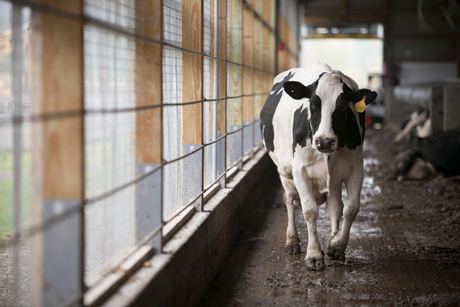$9.9M grant to reduce dairy's environmental hoofprint
By Stacey Shackford

A team of scientists from seven universities – including three from Cornell – has joined forces with the U.S. Department of Energy (DOE) and the U.S. Department of Agriculture (USDA) on a five-year, $9.9 million project to study the environmental impact of dairy production systems in the Great Lakes region and develop best management practices for producers to implement on farms.
Emissions of greenhouse gases and ammonia, soil carbon sequestration, and soil and forage quality will be measured during ongoing dairy forage production field experiments in Wisconsin, Pennsylvania and New York, with the goal of understanding how various management practices and regional climate differences affect carbon, nitrogen, water and energy fluxes across the dairy production system.
The Cornell team includes Quirine Ketterings, associate professor of nutrient management; Curt Gooch, a dairy facility and waste management engineer in the Department of Biological and Environmental Engineering and senior extension associate with PRO-DAIRY; and Larry Chase, professor of animal science and extension specialist in dairy nutrition.
They will lend their expertise in soil and fertility management, manure management, forage use, dairy housing and cow nutrition, as well as outreach.
Their work will include evaluating greenhouse gas emissions from corn fields with long-term manure or compost application history compared to fields managed with a range of inorganic nitrogen fertilizer applications, at the Musgrave Research Farm in Aurora, N.Y.
Cow biology and diet will be analyzed as part of the research conducted at other institutions. The Cornell Net Carbohydrate and Protein System model will be used to evaluate impact of management changes on nitrogen, phosphorus and greenhouse gas emissions for a wide range of feed and environmental conditions.
Other aspects of the research include computer modeling, comprehensive extension and outreach and an agricultural education curriculum.
“This project brings together soil scientists, agronomists, animal scientists, engineers, life cycle analyses specialists, climate change scientists, modelers and extension and education specialists,” Ketterings said. “Collectively, we strive to create more resilient dairy systems that can adapt to a changing climate.”
“It is great to see this group come together and work toward mitigation strategies over the next five years,” she added.
Led by University of Wisconsin-Madison soil scientist Matt Ruark and Molly Jahn, a former Cornell professor now at Wisconsin-Madison, other partners in the grant include: the University of Arkansas, the University of Michigan, North Carolina A&T University, Pennsylvania State University and the University of Washington, along with four USDA Agricultural Research Service laboratories, the U.S. Department of Energy and the industry-sponsored Innovation Center for U.S. Dairy.
The grant was one of two from the Agriculture and Food Research Initiative announced May 7 by USDA Secretary Tom Vilsack. Oklahoma State University also received $9.6 million to lead a collaboration of 32 scientists studying the vulnerability and resilience of Southern Great Plains beef, as part of the Coordinated Agricultural Projects program of the National Institute of Food and Agriculture.
“Farmers and ranchers need sound, science-based information and solutions to help them make management decisions that will sustain their productivity and keep their operations economically viable,” Vilsack said. “We have seen the impact that variable climate patterns have had on production agriculture for the past several years. These projects will deliver the best tools available to accurately measure and respond to the effects of climate on beef and dairy production.”
Stacey Shackford is staff writer at the College of Agriculture and Life Sciences.
Media Contact
Get Cornell news delivered right to your inbox.
Subscribe